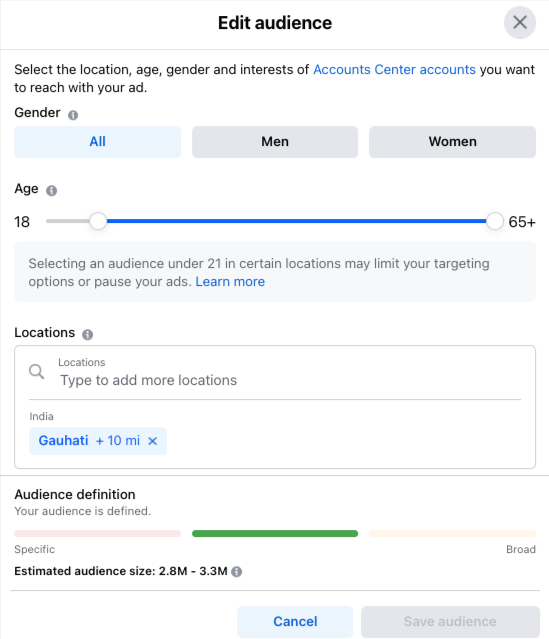Although Facebook began as a socializing platform, over the years, it has evolved into a powerful marketing platform for businesses.
Today, it stands as a towering giant, offering unparalleled reach for its users and targeting capabilities to businesses of all sizes.
However, navigating the labyrinth of Facebook’s ad policies and guidelines can be daunting. Especially when there’s a specter of ad account disablement lurking around every corner.
To help you steer clear of this dreaded fate, we’ve compiled a comprehensive checklist to ensure your Facebook ad account remains in good standing.
But before that, let’s understand why Facebook might disable your ad account.
Why a Facebook Ad Account Gets Disabled
If you have a Facebook ad account, you really need to be careful about what you’re posting. There may be several reasons why your account might get blocked.
To ensure that doesn’t happen, you need to know when such a circumstance can take place. Let’s look at some of the reasons that might lead to your account being blocked or disabled.
1. Keep Policy Violation in Mind
The most common reason for ad account disablement is violating Facebook’s Advertising Policies. This includes using misleading or false content, promoting prohibited products or services, or engaging in deceptive practices.
So before you post anything on Facebook, make sure you double-check that you’re not violating any of the above policies.
2. Follow Ad Content Compliance
Before launching any ad campaign, make sure to review Facebook’s Advertising Policies. Familiarize yourself with Facebook’s Advertising Policies and ensure your ad content complies with them.
These policies cover various aspects, such as prohibited content, community standards, and advertising guidelines. Knowing these policies will help you ensure that your ad content meets their standards.
You should always avoid misleading or false content, and steer clear of promoting prohibited products or services.
Exercise caution when advertising sensitive topics such as health, finance, or politics. Ensure your ads comply with Facebook’s guidelines for these topics.
3. Follow Image and Video Guidelines
Facebook also has strict image and video guidelines for its ad accounts. It’s important that you use high-quality images and videos that are relevant to your ad.
You should also limit text in images to adhere to Facebook’s Text Overlay Tool guidelines. Facebook has been known for rejecting ads that contain excessive text.
It’s also important to keep your video ads concise and engaging. Facebook recommends videos to be between 15-30 seconds for feed ads and up to 120 minutes for in-stream ads. Use recommended video formats (e.g., MP4, MOV) and aspect ratios (e.g., 16:9, 1:1, 4:5) for best results on different devices and placements.
Do not include prohibited content in your images or videos, such as nudity, violence, or illegal activities. Facebook does not entertain or tolerate such content and can quickly ban your ads for it.
3. Be Mindful of Targeting and Audience Selection
If you’ve run ads on Facebook, you must have already seen its targeting and audience selection options. This option is offered to help you maximize your reach to your target audience.

So, make sure to target your ads to relevant audiences based on legitimate interests and behaviors. Avoid targeting audiences based on sensitive attributes such as race, religion, or political affiliation. This might get your account blocked right away.
It’s also crucial to ensure that your ads do not discriminate against any group or individual. Facebook likes ads that are inclusive and respectful.
4. Follow the Landing Page Compliance
Ensure your landing page content aligns with your ad content. Sometimes, marketers use different landing pages that aren’t really relevant to the ad. Facebook considers such ads to be deceptive and might disable such accounts.
Avoid using deceptive landing pages or engaging in “cloaking” techniques, which can result in ad account disablement. Be transparent about your business, products, and services. Provide accurate information and avoid deceptive practices.
You also need to ensure that your landing page functions properly on all devices and browsers. So, test all your links, forms, and interactive elements to offer a seamless experience to your users.
5. Don’t Use Engagement Bait
Another tactic that can get your Facebook ad account banned is engagement bait. You must have seen marketers using engagement bait tactics to artificially boost engagement, such as “like and share to win.”
Facebook’s algorithm is adept at detecting such tactics and may penalize your ad account if you do something like that.
6. Respect Intellectual Property
Obtain necessary permissions for using copyrighted materials and avoid infringing on trademarks or intellectual property rights. This includes images, videos, music, and any other content that is protected by copyright.
Use original content in your ads whenever possible. This avoids any potential copyright issues and ensures your ads stand out as unique. If you need to use content that is not original, ensure you have the proper licenses or permissions to use it in your ads.
If you fail to do that, you might have to face ad disapprovals or account disablements.
Conclusion
Having your Facebook ad account blocked can have significant consequences for your business. It will limit your ability to reach and engage target audiences and hamper your overall marketing and growth strategy.
To prevent that from happening, you need to ensure that you follow Facebook’s ad policies. The above-mentioned policies can help you keep your ad account safe.





